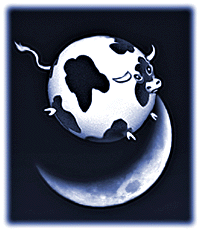Spherical cow

A spherical cow is a humorous metaphor for highly simplified scientific models of complex real life phenomena.[1][2] The implication is that theoretical physicists will often reduce a problem to the simplest form they can imagine in order to make calculations more feasible, even though such simplification may hinder the model's application to reality. The concept is known commonly enough that it is sometimes referred to in scientific discourse without need for further explanation.[3]
Details
The phrase comes from a joke that spoofs the simplifying assumptions that physics students are taught to use as they approach nearly any question:
Q: How does a physicist milk a cow? A: Well, first let us consider a spherical cow...
Or in a more detailed version:[4]
Milk production at a dairy farm was low, so the farmer wrote to the local university, asking for help from academia. A multidisciplinary team of professors was assembled, headed by a theoretical physicist, and two weeks of intensive on-site investigation took place. The scholars then returned to the university, notebooks crammed with data, where the task of writing the report was left to the team leader. Shortly thereafter the physicist returned to the farm, saying to the farmer, "I have the solution, but it only works in the case of spherical cows in a vacuum".
It is told in many variants,[5] including a spherical horse in a vacuum, from a joke about a physicist who said he could predict the winner of any horse race, provided it involved perfectly elastic spherical horses moving through a vacuum.[6][7]
Popular culture
The joke sometimes shows up outside the physics community. In an episode of the sitcom The Big Bang Theory, the joke is told with a slight variation, the punchline mentioning "spherical chickens in a vacuum".[8]
In the 1997 British Channel Four series Brass Eye, host Chris Morris campaigns against spherical cows. He distributes flyers and gets public opinion on the use of spherical cows as food, implying that such cows exist and are secretly being sold in British shops. Response was universally negative, but none of the respondents shown on the program questioned the veracity of the spherical cow's existence.
Consider a Spherical Cow is the title of a 1988 book about problem solving using very simplified models,[9] and "Spherical Cow" was chosen as the codename for the Fedora 18 Linux distribution.[10]
See also
- Assume a can opener
- Fermi problem
- Frictionless plane
- Isolated system
- Occam's razor
- Naïve physics
- Unobtainium
- You have two cows
References
- ^ Shelton, Robin; Cliffe, J. Allie. "Spherical Cows" nasa.gov
- ^ "The Sacred Spherical Cows of Physics"
- ^ Doyle, John (10 May 2001). "Computational biology: Beyond the spherical cow". Nature. 411 (6834): 151–152. doi:10.1038/35075703. PMID 11346778. Retrieved 22 February 2014.
- ^ Washington Post: "The Coase Theorem"
- ^ Kirkman, T. W. (1996). "Spherical Cow: A Simple Model". Statistics to Use. Retrieved 2007-02-19.
- ^ Hefley, Bill; Hefley, William E.; Murphy, Wendy (1 February 2008). Service science, management and engineering: education for the 21st century. Springer. p. 80. ISBN 978-0-387-76577-8. Retrieved 28 September 2011.
- ^ Birattari, Mauro (15 April 2009). Tuning Metaheuristics: A Machine Learning Perspective. Springer. pp. 183–184. ISBN 978-3-642-00482-7. Retrieved 1 September 2012.
- ^ Huva, Amy. "When Nerds go Viral". Vancouver Observer. Retrieved 6 May 2014.
- ^ "Consider a Spherical Cow" University Science Books
- ^ "Fedora 18 Is Codenamed The Spherical Cow". phoronix.com. 2012. Retrieved 2012-05-11.
External links
- NASA:Exploration of the Universe Division - Supernova models as spherical cows
- Hubble Heritage Gallery Page: related history from Space Telescope Institute
